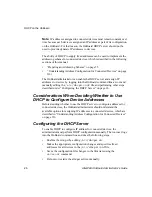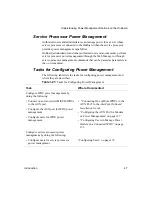
Introduction
35
VPN on the OnBoard
IPSec VPN Connections
For a user to access native IP functionality on a connected service processor,
the user needs to create a VPN connection to the OnBoard; launching an
IPSec VPN connection requires the user to have IPSec running on the
computer being used to manage OnBoard-connected devices.
The ESP and AH authentication protocols (also called “encapsulation
methods”) are supported. RSA Public Keys and Shared Secret are also
supported. Authentication information (username and password and
connection keys or certificates) is needed.
If the RSA public key authentication method is chosen, the generated keys are
different on each end. When shared secret is used, the secret is shared on both
ends.
The values needed for configuring IPSec VPN connections can shown in the
following table.
Table 1-16:
IPSec VPN Configuration Information for Administrators and Users
Value Name
Description
Connection
Name
Any descriptive name you choose.
Authentication
protocol
• AH
• ESP
Authentication
method
• RSA public keys
• Shared secret
Boot action
• Ignore
• Add
• Start
• Add and route
Remote (“Right”)
ID
@
workstation_name.
IP address
IP address of the user’s workstation.
Summary of Contents for AlterPath OnBoard
Page 36: ...xxxvi AlterPath OnBoard Administrator s Guide...
Page 108: ...Understanding How Configuration Changes Are Handled 72 AlterPath OnBoard Administrator s Guide...
Page 116: ...Overview of Web Manager Menus 80 AlterPath OnBoard Administrator s Guide...
Page 146: ...Configuring Regular Users Wizard 110 AlterPath OnBoard Administrator s Guide...
Page 160: ...Upgrading AlterPath PM IPDU Software 124 AlterPath OnBoard Administrator s Guide...
Page 194: ...Configuring an Alternate Help File Location 158 AlterPath OnBoard Administrator s Guide...
Page 292: ...Configuring Private Subnets and Virtual Networks 256 AlterPath OnBoard Administrator s Guide...
Page 344: ...Using the create_cf Command When Troubleshooting 308 AlterPath OnBoard Administrator s Guide...















































